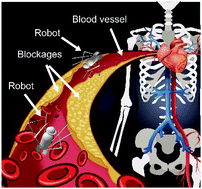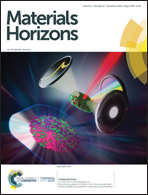Microscopic hollow hydrogel springs, necklaces and ladders: a tubular robot as a potential vascular scavenger†
Abstract
Microscopic hollow hydrogel fibers are capable of being used as carriers, scaffolds and actuators for biomedical applications. However, preparation of sophisticated geometries remains a challenge. We herein present a non-coaxial microfluidic method, which is different from traditional coaxial devices that form perfusable channels during the extruding process. Our method produces solid microfibers into tris(hydroxymethy)aminomethane–HCl buffered solution containing CuSO4 and H2O2 elements, where chemical reactions contribute to hollow structures. The process doesn’t require coaxial nozzles, whereby it allows generation of sophisticated geometries with interconnected channels including single- and double-helical springs, necklaces and ladders by adjusting the distance between the nozzles and liquid level. After magnetizing the hollow microfibers, they can be steered by magnetic actuation to generate controllable movements and to navigate across unstructured environments in liquid systems. The hollow microfibers are non-toxic. We thus show an interesting concept by preparing hollow microfibers into a tubular small-scale robot that can shift inside an artificial blood vessel to clean up blockages, demonstrating potential application as a vascular scavenger.

- This article is part of the themed collection: 2019 Materials Horizons Most Popular Articles


 Please wait while we load your content...
Please wait while we load your content...